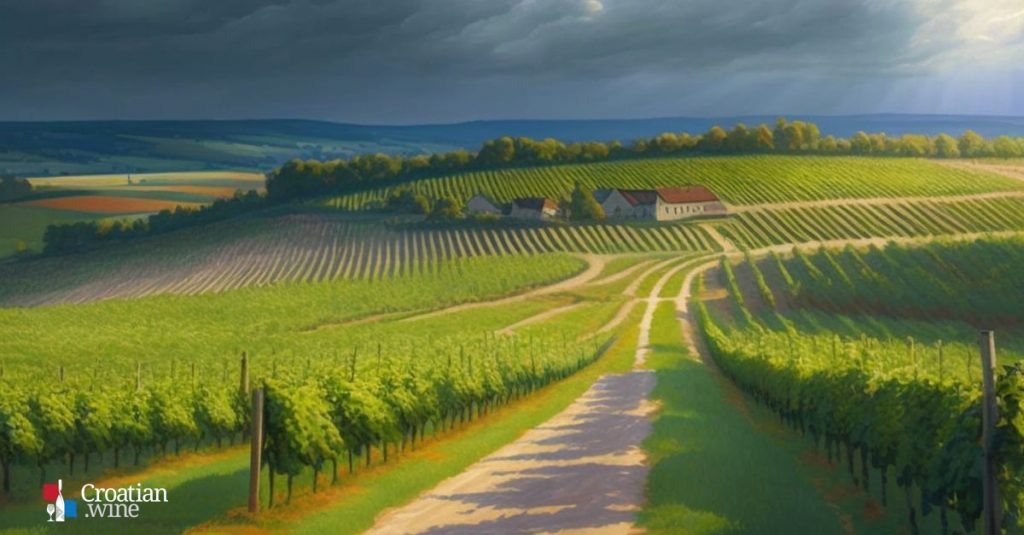
Exploring the world of Croatian wine is a journey filled with discovery. From its continental and Mediterranean climate, Croatia produces unique and delicious wines made from indigenous grape varieties such as Malvazija, Plavac Mali, Babić, Graševina, Grk, Pošip, Maraština, and many more. For those looking for something new or exciting in their next bottle of wine, look no further than these Croatian grape varieties. From where it comes from to what kind of flavor profile you can expect – so get ready for an adventure to become Croatian wine grape expert! This blog post will dive deep into Croatia’s diverse and exciting wine scene!
Introduction to Croatian Wine
Grape cultivation in today’s Croatia has a rich wine history and viticulture tradition that dates back to the 5th century BC. Croatia is home to some unique and exciting grape varieties not found anywhere else in the world. Like in other old-world wine countries, wine is produced from many traditional grape varieties, perfectly adapted to their local microclimate.
There are four major wine regions:
- Dalmatia
- Istria and Kvarner
- Croatian Uplands
- Slavonia, and Danube.
Each region produces a mix of whites and reds – from indigenous and international grape varieties. Let’s take a closer look at their characteristics:
- The Istria wine region has a pleasant Mediterranean climate with mild winters and dry and warm summers. The region’s dominant indigenous white grape variety is Malvasia Istriana (or Malvazija). Teran is an indigenous red grape variety cultivated in Istria for centuries;
- With its cool continental climate, the Slavonia and Danube wine region produces one of the unique native whites – Graševina. As for the reds, international varieties such as Merlot, Cabernet Sauvignon, Pinot Noir, Frankovka (Blaufränkisch), and Zweigelt dominate.
- Croatian wine from Dalmatia is exceptional, thanks to the region’s unique climate and terroir. The most famous indigenous white grape varieties are Pošip, Grk, Maraština, Kujundžuša, and Debit. The reds in Dalmatia include Plavac Mali, Babić, Crljenak Kaštelanski, Plavina, Lasina, Dobričić.
- The Croatian Uplands wine region, in the northern part of the country, is predominantly known for its old, indigenous varieties like the Škrlet, Pušipel, and Kraljevina. The most common reds are the international varieties Pinot Noir and Portugieser.

To learn more about Croatia’s most famous indigenous grapes, read about their origin, characteristics, and food pairing recommendations. Find other exciting information along the way and become a Croatian wine grape expert!
Malvasia Istriana Grape Variety
Malvasia Istriana (Malvazija) is a white grape variety native to Croatia that has been present in Istria for centuries. It is known for its floral and fruity aromas, as well as its light to medium body and crisp freshness.
Origin and Characteristics: Malvazija thrives in Croatia’s largest peninsula, Istria. Grapes are large berries that turn green-yellow or fully golden in the warmest locations. This variety produces high yields of flavorful grapes grown in mild Mediterranean climates. Most Malvazijas will exhibit fruity stone aromas, like peach or apricot, with acacia blossom floral aromas being the most common. Often there will be some mineral and almond notes to your Malvasia wines. яндекс
Food Pairings and Serving Suggestions: Malvazija pairs well with seafood dishes due to its lively freshness or typical Istrian dishes – frittata (egg omelett) and fuži (local pasta dish). It won’t overpower delicate flavors but still provides enough structure to stand against heartier ingredients like olives or feta cheese. When serving this wine chilled, do it at around 10 – 12°C (50 – 53°F).
Now, explore the Graševina grape variety to learn more about its unique characteristics and flavor profiles!
Key Takeaway: Malvazija is a white grape variety native to the Istria peninsula. A range of styles goes from light and fruity, floral ones to sweet or orange wines.

Graševina Grape Variety
With its thin-skinned, medium-sized berries and notable freshness, Graševina finds its best expression in the Slavonia and Danube wine region.
Origin and Characteristics: Graševina is indigenous to the Slavonia and Danube region, known for its vast plains that give way to hills, fertile river basins, and valleys filled with vineyards. Wines from the Graševina grape variety offer fragrances, including tropical fruits, citrus, green apples, and delicate herbal nuances. Styles can range from dry to semi-sweet and sweet dessert wines (e.g., Ice Wine). Depending on the winemaker’s preference, Graševina can show many faces.
Food Pairings and Serving Suggestions: Serve Graševina wines at 10-12°C (50-53°F) for optimal enjoyment. Graševinas are paired well with grilled fish and salads covered in olive oil or vinaigrette dressings. For added complexity, pair your wine with roasted vegetables such as mushrooms or eggplant sprinkled with herbs to bring out their unique fruit aromas.
Plavac Mali is our next stop, the most famous indigenous Croatian red grape variety!
Key takeaway: Graševina is a native white grape variety of Slavonia and the Danube region. An eclectic flavor profile with zesty notes of tropical fruits, citrus fruit, and green apples will tantalize the taste buds.
Plavac Mali Grape Variety
Plavac Mali is a red grape variety native to Croatia’s Dalmatian Coast. Plavac Mali grapes are grown primarily on the islands off the coast of Croatia, mainly on the Pelješac Peninsula. Wines are medium-bodied yet powerful wines with complex aromas and ripe fruit flavors, making them perfect for aging over several years if desired.
Origin and Characteristics: This variety thrives in hot climates with plenty of sunshine. The vineyards are on steep hillsides facing south or southwest to maximize sun exposure which helps ripen the grapes fully while retaining balanced acidity levels.
Plavac Mali produces full-bodied wines with bold tannins, lower acidity, intense dark fruit, sage, dried figs, and carob aromas.
One of the best-known representatives of Plavac Mali are wines produced from the appellations called – Dingač and Postup. Vines are planted on steep slopes overlooking the Adriatic Sea, producing unique flavors that distinguish it from other Croatian wine red wines. The wines produced from Dingač and Postup appellations were the first Croatian wines to be recognized as quality wines with protected designation of origin (PDO).
Food Pairings and Serving Suggestions: Plavac Mali and steak or barbeque are a perfect match. The rustic character of the wine pairs well with anything smoky. It is best to decant it for at least an hour at 18°C (65°F) before drinking so that all the flavors can open up properly.
Let’s head to the Pošip grape variety and learn more about this hidden white gem of the Dalmatian wine region!
Key Takeaway: Plavac Mali is a red grape variety native to the Dalmatian wine region that produces full-bodied wines with bold tannins, lower acidity, and intense aromas of cherries, sage, dried figs, and carob. It thrives in hot climates and, when served, should be decanted for at least an hour before drinking. Famous examples include Dingač and Postup from Pelješac Peninsula.

Pošip Grape Variety
The Pošip grape variety is a white wine grape native to Croatia’s Dalmatian Coast. It has been cultivated in this area for centuries and is known for its unique flavor profile. The grapes have medium-sized berries with thick skins.
Origin and Characteristics: The Pošip grape variety originates from the Croatian island of Korčula on the Dalmatian Coast. It is a relatively high-yielding variety that produces mostly dry wines with refreshing acidity, high viscosity, and higher alcohol levels. The aromatic profile opens with dry citrus, apricots (more towards dried fruit), and figs aromas. Vanilla and almond aromas tend to come with oak age.
Food Pairings & Serving Suggestions: Wines made from Pošip grapes serve chilled at 10-12°C (50-53°F). When it comes to food pairing, it is another traditional seafood wine. Pošip is ideal for seafood dishes like octopus salad, smoked white fish, or baked cod with asparagus and capers. More structured and oak-aged versions are rich enough to be a delicious pairing with hard cheese, pork chops, and veal.
Next, discover more about the Babić grape variety, an indigenous and unique Croatian red grape variety!
Key Takeaway: The Pošip grape variety is a white wine grape native to Croatia’s Dalmatian Coast region. Fantastic on its own and an equally good pairing to most Dalmatian dishes, especially fish and shellfish, while the oak-aged version can pair well with pork chops or veal.
Babić Grape Variety
With its origin dating back centuries, the Babić grape variety is a treasured native red wine varietal in Dalmatia.
The berries of this vine possess the medium size and thick skins that contribute to its prominent tannins and make it ideal for creating medium-bodied to more robust reds.
Origin and Characteristics: Babić, originating from the Dalmatia wine region, is a low-yielding variety. Wines from this indigenous variety are dense and textured thanks to generous tannins. These wines’ most common flavors to shine through are marasca cherries, figs, and subtle herbal hints.
Food Pairings & Serving Suggestions: Serve Babić wines at 18-20°C (64-68°F). Its palate strikes a perfect balance between ripe fruit flavors and firm tannins – making it ideal for pairing with game meat, lamb, or hearty stew.
Explore another Dalmatian native grape variety, an extremely rare and delicious Grk!
Key Takeaway: Babić is an indigenous red grape variety grown mainly in the Dalmatia wine region, which produces dense and tasty wines that are highly valued.
Grk Grape Variety
The Grk grape variety is a white grape native to the Dalmatian island of Korčula. It is primarily grown in the region of Lumbarda and has been cultivated there since ancient times. The Grk grape produces wines that are medium-bodied with a pretty intriguing edge.
Origin and Characteristics: Wines made from the Grk grape are typically dry and savory on the palate with naturally high sugar content and balanced acidity. Some famous examples of Croatian wine from this variety show aromas of candied citrus fruits, melons, macchia, figs, and meadow flowers with a hint of pine.
Food Pairings & Serving Suggestions: Perfect pairings for Grk wines include seafood dishes such as grilled fish or shellfish, salads with feta cheese or olives, and lighter pasta like spaghetti alle vongole (spaghetti with clams). For serving suggestions, it’s best to taste these wines chilled at 10 – 12°C (50 – 53°F).
The Maraština, a versatile white grape, is the variety we’ll cover next!
Key Takeaway: Grk is a white grape variety that produces wines with citrus and tropical fruit aromas. Its medium body, balanced freshness, and crispness make it an example of a rich Croatian wine scene.

Maraština Grape Variety
Maraština, a white wine grape variety native to Croatia’s Dalmatia wine region, has been in this area for centuries. Its medium-sized berries with thin skins exhibit freshness, making Maraština an excellent choice for producing crisp yet complex white wines.
Origin and Characteristics: The Maraština grape variety originates from the Croatian region of Dalmatia. Some famous examples of Maraština are rich, sumptuous, and creamy in the mouth and very attractive to the nose with numerous citrus and stone fruit aromas with hints of Mediterranean herbs. They exude freshness with a lot of body and depth.
Food Pairings & Serving Suggestions: To best savor an excellent Maraština wine, ensure to taste it at 10°C (50°F). Furthermore, serve this wine with food with a more delicate aroma. We recommend hard cheeses, poultry, especially sea bream or sea bass.
Key Takeaway: Maraština is a white wine grape native to Croatia’s Dalmatia region. With its unique characteristics of rich texture and balanced freshness, you won’t be disappointed with this versatile white grape variety!
FAQs About Croatian Grape Varieties
What wine grapes grow in Croatia?
Croatia is home to more than 250 different grape varieties, of which 130 are native. The most famous Croatian native grape varieties are Malvasia Istriana, Graševina, Pošip, Maraština, Grk, Debit, Pušipel, Škrlet, Kraljevina, Kujundžuša, Vugava for white ones, and Plavac Mali, Babić, Teran, Crljenak Kaštelanski, Lasina, Plavina, Dobričić, for the red ones. Additionally, Croatia produces sparkling wines and white and red wines from various grape varieties, both native and international ones. Most famous white grapes are Chardonnay, Rhein Riesling, Gewürztraminer, Pinot Grigio, Sauvignon Blanc, and Cabernet Sauvignon, Merlot, Cabernet Franc, Blaufränkisch, Zweigelt and Syrah of red wine grapes.
Depending on climate conditions and soil type, these grapes are grown in multiple regions throughout Croatia. Each area offers unique characteristics that make its wines distinctively Croatian.
The most common indigenous red grape variety is Plavac Mali, grown in Dalmatia, while the most popular white grapes are Graševina, grown in Slavonia and Croatian Uplands. Here is the list of the top 10 varieties grown in Croatia.
The most common indigenous red grape variety is Plavac Mali, grown in Dalmatia, while the most popular white grape is Graševina, grown in Slavonia and Croatian Uplands. Here is the list of the top 10 varieties grown in Croatia.
Table: Share of Top 10 Croatian Wine Varieties
| Variety | Wine Colour | Share of Varieties | The area under the wine grape varieties with PDO, ha |
| Graševina | white | 31.57% | 5,878.49 |
| Other varieties | 20.73% | 3,860.03 | |
| Malvasia Istriana | white | 11.37% | 2,117.15 |
| Plavac Mali | red | 10.20% | 1,899.29 |
| Merlot | red | 5.73% | 1,066.95 |
| Cabernet Sauvignon | red | 4.72% | 878.89 |
| Plavina | red | 4.28% | 796.96 |
| Chardonnay | white | 4.19% | 780.20 |
| Rhein Riesling | white | 3.95% | 735.51 |
| Blaufränkisch | red | 3.28% | 610.75 |
| TOTAL: | 18,620.50 |
Which Croatian wine is best?
Croatian wine is diverse and complex, with various grape varieties, styles, and regions to explore. Each region has unique characteristics that make it special. Depending on your preference for flavor profile or food pairing potential, there are many excellent Croatian wines for every wine enthusiast.
Whether you prefer a light and fruity white or a bold and spicy red, Croatia has something for everyone – so don’t be afraid to experiment.
We recommend tasting the wines from native grape varieties such as Plavac Mali, Malvasia Istriana, Graševina, Pošip, Grk, Babić, Maraština, Teran, Škrlet, Pušipel, Kraljevina. And then head to try wines made from international varieties such as Chardonnay, Sauvignon Blanc, Pinot Grigio, Rhein Riesling, Gewürztraminer, Merlot, Cabernet Sauvignon, Cabernet Franc, Sauvignon Blanc, Blaufränkisch, Syrah, and Zweigelt.
What type of wine is Croatia known for?
Croatia is known for producing unique wines. Popular types of white wines are Graševina, Malvasia Istriana, Pošip, Grk, Maraština, Pušipel, Škrlet, and Debit. Famous indigenous reds are Plavac Mali, Babić, Teran, Crljenak Kaštelanski, Dobričić, Plavina, and Lasina.
Each region has a unique terroir that gives each Croatian wine its flavor. These wines are produced from particular grape varieties and have already gained recognition for their quality and complexity. From dry whites to sweet dessert wines and everything in between – Croatian wine has something for everyone.
Conclusion
Croatian grape varieties are a unique and exciting way to explore the world of wine. From Malvazija, Plavac Mali, Graševina, Pošip, Grk, Maraština, and Babić grapes, Croatian winemakers have crafted an array of wines that reflect the terroir and microclimate of their region.
Whether you’re looking for a special occasion bottle or want to try something new, exploring the delicious world of Croatian grape varieties is an unforgettable experience!
Explore the world of Croatian wine! Discover unique grape varieties and learn about their stories. From Slavonia and the Danube region, Istria to Dalmatia and Croatian Uplands, find a perfect match for your taste buds.
Experience the diversity of Croatia’s climate through its wines and ensure you take advantage of this exciting journey to become a Croatian wine grape expert. Join us in uncovering all that Croatia has to offer – an adventure awaits!
